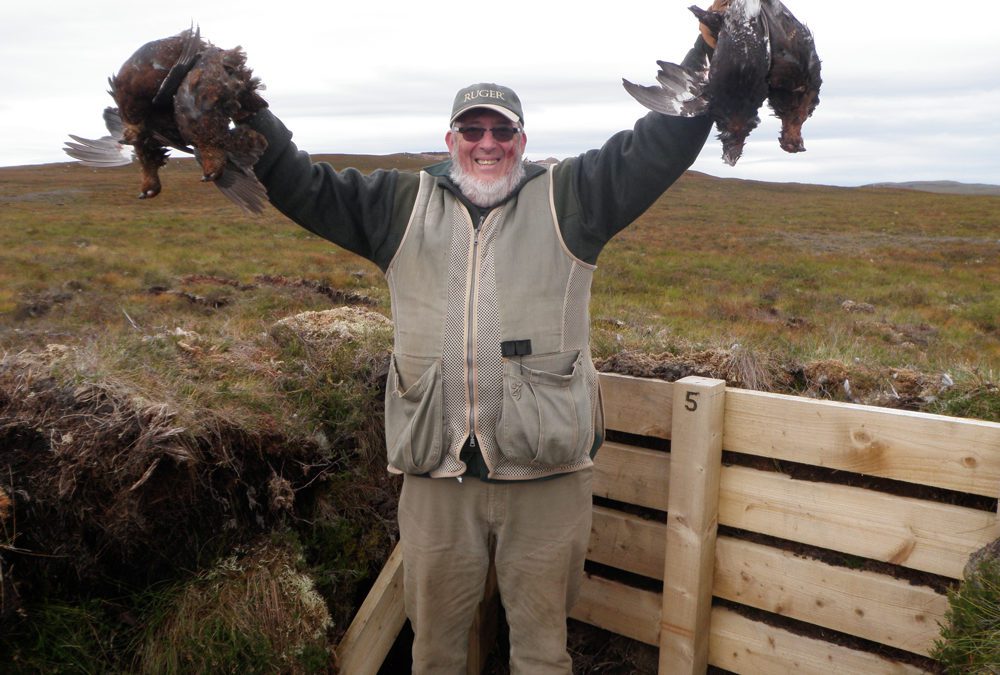Three generations of ruffed grouse hunters were in Scotland last week: Jim, the father; David, the son; and Aidan, the grandson. Members and friends of my family were with them, bird hunters all.
In America, the ruffed grouse is considered the king of the uplands. In Europe, the red grouse is the king of the moors, and the Spanish partridge is a prince. We Yankee gunners had booked four days of bird hunting in the highlands of Scotland—one day of driven grouse, a day of walk-up grouse, and two days of driven partridge. Driven birds would be a new experience for all of us, one we had been anticipating for two years.
Boston to Inverness by air; Inverness to Cawdor by car. The talk, the anticipation, the tension, the expectations traveled with us. We talked about weather, guns, dogs, and ammunition, about the little we knew of drives and the flight patterns of the birds. We arrived in the dark; we did not even get a glimpse of the still-mysterious moors. We ate, we organized our gear, and finally we slept—fitfully—in the estate’s comfortable hunting lodge. Red grouse in the morning. Driven red grouse.
The “gun room” was a separate building built of stone with a steel door and two locks. You’d need a battering ram to get in without permission . . . or dynamite. We met there before breakfast to put our shotguns together. A large table was in the center of the room, ammunition cabinets were on the left wall, and racks for shotguns stretched along the wall in front of us.
I watched as Jim assembled his Boss and matched pair of Churchills; David his fine, high-grade Beretta; Bill his 16 gauge made by the Scotsman Daniel Fraser (the gun was home again); Amos his Brownings. I assembled my 16-gauge William Ford and a Browning 325. Lord Cawdor’s matched pair of highly engraved London Best sidelocks were in their place on the far right, making all save the Boss and Churchills look plebian.
Aidan would use one of his grandfather’s Churchills. Out of respect to the red grouse, we all were wearing neat Yankee hunting attire; Bill had on a tie, and I was wearing a new Ruger hat. We were ready.
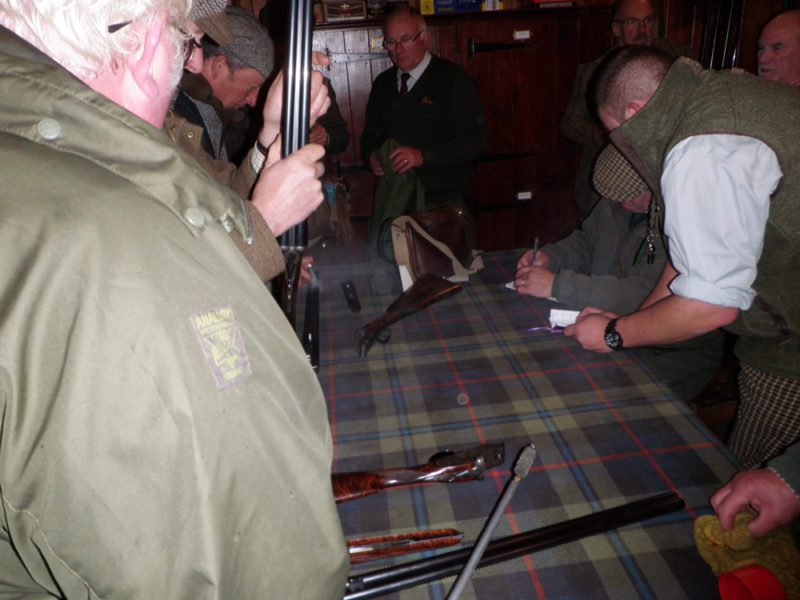
In the gunroom.
Breakfast, then a meeting with our loaders and gamekeepers and into the four-wheel drives. Up we drove out of the river valley onto the moors and then higher onto the moors of the hilltops. Too late in the season for full purple, but the shin-high growth was bleak and beautiful. We saw grouse running and then flying out of the dirt tracks and trails ahead and beside us. We grinned. Finally, sight of our quarry.
Seven shooters took the field: myself, Bill, Amos, Anne, Jim, David, and Aidan. Tripp, our eighth shooter, was en route, delayed by a college midterm exam. We walked onto the moors with our loaders to the butts. Janet, Gale, and Barbara, our non-shooters, came with us to watch: Janet with me, Gale with Bill, Barb with Amos. Our loaders—stuffers really; no one was shooting a pair, and the loaders would stuff the shells into our guns after we fired and ejected—carried our cased shotguns and much ammunition.
I had drawn butt number one, so Janet and I peeled off from the marching group with my stuffer, Gordon. The butt was a deep hole dug in the moor and lined with stone and wood. Ours was old and, by age and tradition, had a dirt—i.e. mud—floor. The top six inches of my chest, my shoulders, my arms, and my head were exposed.
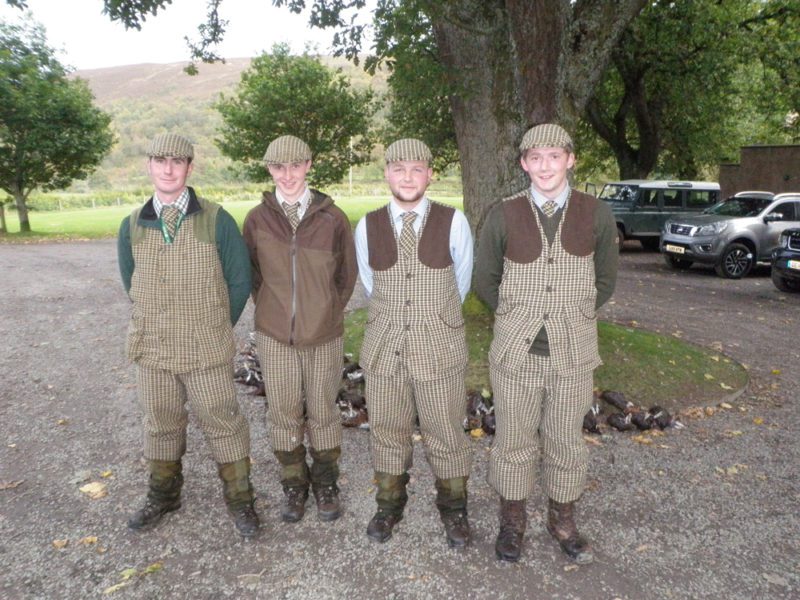
Gamekeepers in Cawdor colors.
Gordon put a wooden “railing” up on both sides of the butt to stop me from swinging too far and shooting in the direction of another hunter or a blocker. Gordon uncased my 16 gauge and loaded it, then I rested the barrels on the top edge of the butt. Forty-five yards in front of me was the top of a ridge.
“They’ll be coming over that hill and at us low and at high speed with the wind behind them,” Gordon warned me. “Mount your gun as soon as you see them, point, and shoot. If you delay you’ll shoot behind or they’ll be past you. I’ll spot birds for you and call right or left.
“Get ready, they . . .”
A shot and then another on the far right finished his sentence. I could not see the action. Only David and Jim were in view on the right, the others out of sight over a slight rise. More shots on the right. It sounded like they were under attack, and the defenders were shooting very quickly—busy times for the shooters and stuffers.
“On the left, sir. Fast and low.”
I peered, I looked, and whoosh! The bird went blazing by five feet from my left ear. No skyline; he flew low and blended into the moor until I had no chance. And fast! That bird went past me like a teal on the first pass. There and gone. Pray for 20 feet up and skylines.
Then, 15 seconds later, “Three on the right, sir.”
As I looked I brought my gun up, found a bird, fired, missed behind it, and had my second shot stopped by the safety barrier. As I looked at the barrier and smiled bleakly, I saw David make a beautiful shot on an incoming bird—feathers left in the air and a bird on the moor.
“In front, sir.”
I turned to the front, saw 15 birds coming at me, and—say the word—flock-shot. But I did empty both barrels. Eject, stuff, “On the right, sir.” Bang, bang. Swung so hard I slipped in the mud. Feathers in the air.
“You feathered him, sir. Still shooting a bit behind. Dogs’ll find him.”
And so it went. For 20 minutes. On the right I saw Jim shoot a double with his Boss. He picked his two birds out of a flurry of 30 incomers. I shot, muttered, and shot again. Feathers and more feathers. Behind, over, or to the side. Finally I got ahead of an incomer and folded it up into the wood of the left safety barrier. A fast snap shot and a clean kill.
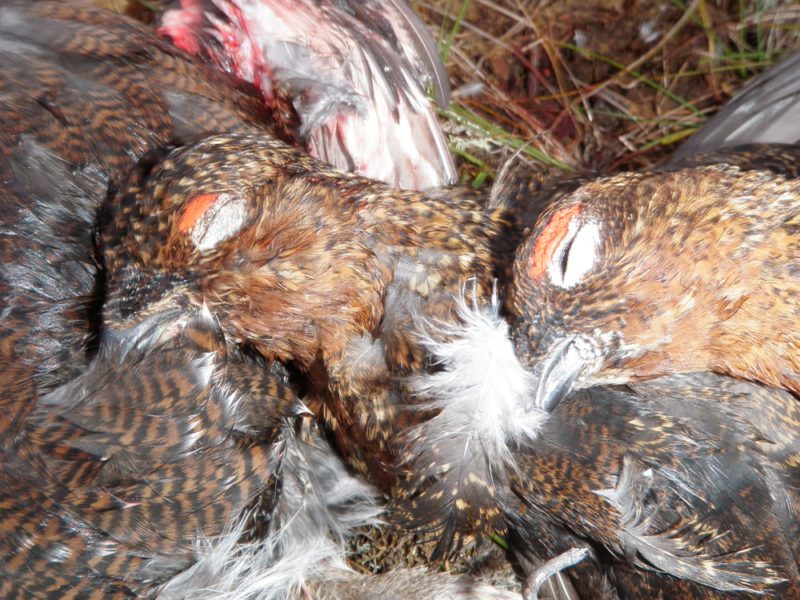
Two of a kind.
Then the horn blew and we turned around. The beaters were too close in front of us. Only going-away birds now.
“Two birds on your right, sir.”
I got on the right one quickly as it passed and folded it at 35 yards. Going-away shots I understand. No chance at the other grouse. These birds were fast. Then I heard the flapping of the beaters’ flags as they approached. More shots, and I saw David drop another, a clean kill.
The horn blew again; I unloaded and handed my gun to Gordon. We picked up the spent shells—31 of them—and I climbed out of the butt and picked up one of my two clean kills. Beautifully russet with bright red over the eyes—a male.
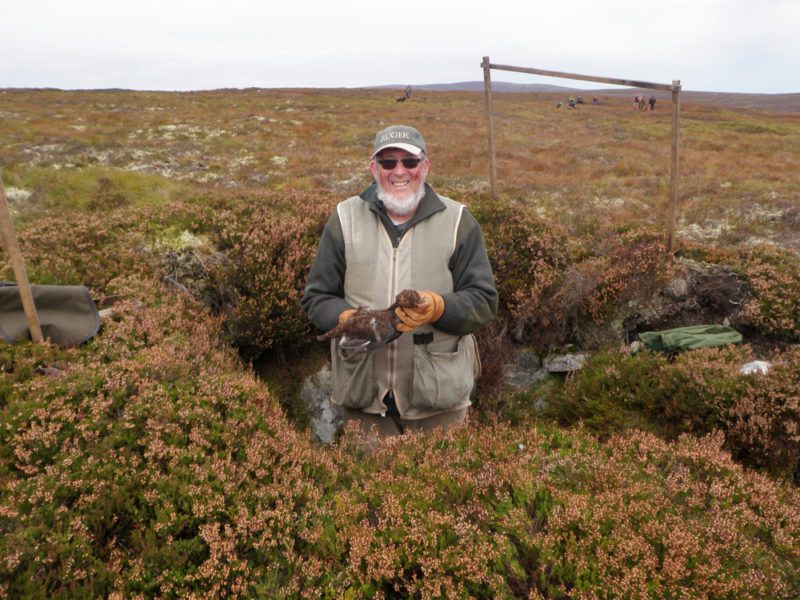
The author with his first red grouse. Note the wooden gun blocks along the edge of the butt.
“First red grouse, sir. Congratulations.”
I smiled and watched the happy little cocker spaniels track down the downed birds.
“The dog work is much better than my shooting. I’ve got a lot to learn.”
“Yes, sir. And five more drives today to educate yourself.”
I smiled, agreed, and greeted my friends. We’d learn. And we did . . .
Stay tuned for the conclusion of the author’s Scottish hunting adventures.

